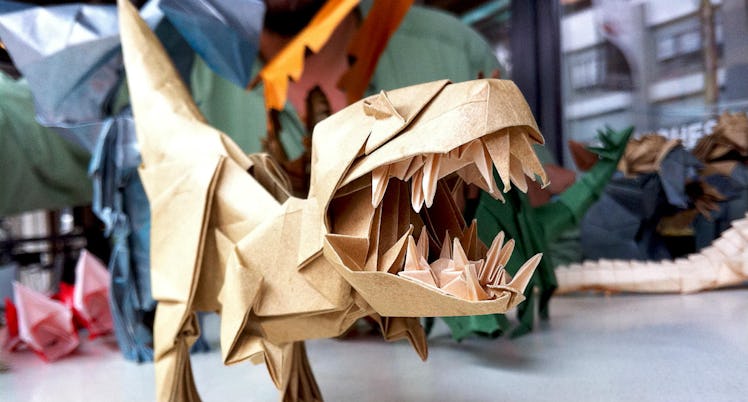Show Your Kid How To Fold Paper With A Guy Who Made An Origami Jimmy Carter
Get that paper, son!

For more advice on fun stuff to do with your kids, from ridiculously overqualified experts, check out the rest of our 940 Weekends.
If your kid just can’t seem to remember that “markers are for paper, not walls,” maybe it’s time to disengage the art supplies from the situation. Enter: origami, the ancient Japanese art of folding paper into decorative shapes, animals and figures.
Robert J. Lang is a former NASA physicist who’s built an incredible folding portfolio of original designs, from origami Darth Vaders and Jimmy Carters (hey, it was the 70s) to tiny violin players and just about any animal or insect you can think of. You know you’re an origami badass when The New Yorker profiles you.
Still, Lang doesn’t just create designs only a rocket scientist can understand. Here are his tips for helping your kid fold their way to a new pet pegasus, airplane, or life-size paper best friend. If nothing else, it should make them more useful when you’re folding laundry.
Get That Paper
Your kid’s origami hobby probably isn’t going to be all that lucrative, but at least the overhead is cheap. Any old paper will do, even old paper. “For years I folded paper from obsolete forms that my dad brought home for work. He could get those for free because they were being thrown out. I could try it without having to spend any money and indulge in it as much as I wanted to,” says Lang.
Cranes Are For The Birds
If you read Sadako and the Thousand Paper Cranes as a kid and then tried to make a thousand-crane flock of your own, you know folding those little birds ain’t easy. It’s one of the most iconic patterns, but that doesn’t mean it’s the one kids should start with. “Origami folds have different levels of difficulty,” says Lang. “It’s tempting to dive in at the deep end and say ‘Ooh, there’s this complex dragon with scales and claws’, but you need skills to develop. There are thousands of designs at all different levels.” Start with books and patterns marked “simple,” “low,” or “intermediate.”
Stay Inside the Lines
Children aren’t known for neatness or patience, but keeping their every fold on point will really pay off later in the pattern. “Probably the biggest tip that I give is to focus on folding neatly and precisely rather than on trying to get to the end of the instructions,” says Lang. “When you’re folding, the instructions are kind of a puzzle: You are solving a whole set of little problems and trying to get to the end. But I encourage folders not just to focus on accomplishing the step, but to accomplish it as neatly and precisely as possible.”
The more exact their folding now, the closer they’ll be to making those giant paper dinosaurs at the back of the pattern book. “I don’t think kids realize how direct the connection is between neatness and folding more complicated stuff,” Lang explains. “It’s worth having a parent point that out, rather than the kid having difficulty and saying, ‘It’s not working, I hate this.’”
Learning Origami Is Multimedia
Lang recommends using both books and origami’s YouTube stars to learn new folds. “I don’t say ‘Always do books’ or ‘Always do video.’ Different people learn differently, and folks should try both,” says Lang. “Videos have a nice advantage in that they show the motion happening. But the picture in the book is static and you can study it forever — usually the important lines are highlighted and very visible.”
Enter The Fold
If your kid has big paper folding dreams, there’s a whole world of like-minded practitioners they can commune with. “There are online forums and mailing lists devoted to origami, and conventions and groups in many different cities, and generally these are very family-friendly,” Lang shared. “I think they’re valuable resources because it’s useful in terms of social development and satisfaction for kids to interact with other kids who have the same passion.” And if they’re really into paper, maybe you can help them get a job at a real-life Dunder Mifflin.
It’s A Gateway Art
Designing your own origami patterns is some next-level Tom Foldery, but if your kid wants to make that leap, getting into drawing and sculpture will help. Lang says “being able to recognize negative space and silhouettes and outline a proportion” is key. And he always recommends sketching out how you want a completed design to look before working to create the pattern for it yourself. “If you’re folding paper, it will make you better at drawing. If you’re drawing and designing your own folding instructions it will help you convey information clearly so it’s understandable by others.”
Remember: It’s Just Paper
If a design isn’t going well, your kid can rip it up, crumple it up, burn it (just kidding — don’t burn it) and grab another sheet of paper. “A factor that makes origami good for kids is that the penalty for messing up is not that high. If paper rips,or wrinkles you just throw it away and try it again,” says Lang. Incidentally, that’s not bad advice for life in general.
This article was originally published on